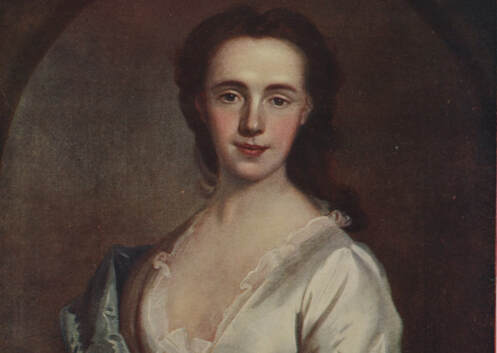COLONEL ANNE FARQUHARSON (1723-1787)

Born in 1723, Anne Farquharson was the eldest of two daughters of John Farquharson of Invercauld, Chief of the Aberdeenshire Clan Farquharson, and his third wife, Margaret, daughter of James Murray, first Marquis of Atholl. The Farquharson family were staunch Jacobites and, although her father had been captured during the first Jacobite Rising in 1715 at the Battle of Preston and incarcerated in Marshalsea Prison for ten months, he was given a reprieve on the morning of his planned execution at the Tower of London. Of all the surviving children of his four marriages, it was Anne who would most passionately continue to champion the cause.
By the time of the second Jacobite Rising in 1745, Anne was in her fourth year of marriage to Aeneas (Angus) Mackintosh, Chief of Clan Mackintosh and of Clan Chattan, a confederation of 12 Scottish clans including the Clan Farquharson. When the news swept across the country that Prince Charles Edward Stuart (aka. Bonnie Prince Charlie) had raised his standard at Glenfinnan, the time had come again for the people of Scotland to declare their allegiance, whether to the ruling House of Hanover or to the hope of restoring the House of Stuart to the British throne. For many Scots women at the time, the notion of a Prince setting out on such an impassioned, personal quest may have sparked romantic ideas, not least for the 22-year-old Lady Anne Mackintosh. With her Jacobite pulse racing, she is believed to have urged her husband to raise troops from Clan Chattan in support of the Prince. However, even Anne must have realised this was highly improbable, as Angus was already a serving Captain in The Black Watch, a regiment formed under the Hanoverian Government of George II to police and keep the peace in the Highlands.
What was to follow became one of the most extraordinary pairings in the country’s history. Whether by secret, mutual accord with Angus or in brazen defiance of him and the uniform he wore, Anne courageously raised over 350 Mackintosh and Farquharson clansmen to fight in the Clan Chattan Regiment for the Prince, thus putting herself and her husband on opposite sides of the war while living under the same roof. She is believed to have ridden extensively to various clan homelands in her efforts to raise troops, sometimes forcibly. Adorned in a tartan riding habit trimmed with lace, and with pistols at her saddle-bow, Anne also sported a blue bonnet with white cockade, representing the Jacobite Rose.
The Prince, very taken by both Anne’s beauty and her selfless support for the cause, would affectionately refer to her as “La Belle Rebelle.” They enjoyed a close friendship and he clearly felt safe in her company. In February 1746, the Prince was staying as a guest at Moy Hall, Anne’s marital home, south of Inverness, in Angus’ absence. When Lord Loudon got wind of this, he immediately planned a night march from Inverness to Moy, intent upon capturing the Prince and claiming the £30,000 bounty that had been placed on the Prince’s head. Although Loudon had cordoned off Inverness to avoid news of his planned raid escaping, a 15-year-old messenger, despatched by Anne’s mother-in-law, managed to alert Anne to the approach of Loudon’s 1200-strong force. Anne immediately sent a handful of her staff to stall their advance while the Prince took refuge by the water’s edge of the nearby Loch. Chanting the battle-cries of several of the Chattan Clans while delivering sporadic musket fire, Anne’s trusty team not only managed to thwart the advance of the Government troops but caused them to hastily retreat to Inverness in general panic. The bluff ambush would become known as The Rout of Moy. Emboldened by this event, the Prince and his troops then seized Inverness.
Following Angus’ subsequent capture, Prince Charlie paroled him into Anne’s custody, stating “he could not be in better custody, or more honourably treated.” Upon accepting charge of her familiar prisoner, Anne is recorded as having greeted her husband with the words, “Your servant, Captain,” to which Angus’ reply, “Your servant, Colonel!” is thought to have inspired her nickname of Colonel Anne.
In the aftermath of the Battle of Culloden in April 1746, at which many clansmen lost their lives at the hands of Prince William, Duke of Cumberland’s army, Anne was taken prisoner and paroled into the custody of her mother-in-law in Inverness for six weeks, later being released without charge into her husband’s care. However, during her custody, Anne busily plotted with other women to enable the escape of Robert Nairn, a Jacobite Officer, and then successfully intervened to prevent an accomplice, Anne McKay, from being dragged and whipped through the streets of Inverness.
Anne and Angus both survived the “’45”, as too did their marriage. Years later, when they attended a social event in London, Anne’s characteristic feistiness was once again on public display – for when invited to dance to a government tune by the Duke of Cumberland, she accepted on the condition they then dance to a Jacobite air.
Anne died aged 64 in Leith, Edinburgh, on 2nd March 1787, outliving Angus by seven years. She is buried in Old North Leith Burial Ground, where her grave is marked by a white rose. While Anne’s courage and service to the Jacobite cause were unsurpassed among the women of her generation, history has unfairly given the spotlight to Flora MacDonald whose family were generally pro-government and who claimed she only helped Prince Charlie escape to the Western Isles out of sympathy.
2023 marks the tricentenary of Anne’s birth and it is now her time to shine and for Scotland to remember the nation’s most courageous, Jacobite daughter. Although Anne didn’t fight in battle, having appointed her husband’s cousin, Alexander MacGillivray, to lead the Clan Chattan force, she was clearly a motivational and inspirational leader in her own right. Fair, fearless and feisty, Anne embodied female empowerment in a very male-dominated world.
Entry written by Jonathan Findlay.
Further Reading
www.anne300.com (in development)
By the time of the second Jacobite Rising in 1745, Anne was in her fourth year of marriage to Aeneas (Angus) Mackintosh, Chief of Clan Mackintosh and of Clan Chattan, a confederation of 12 Scottish clans including the Clan Farquharson. When the news swept across the country that Prince Charles Edward Stuart (aka. Bonnie Prince Charlie) had raised his standard at Glenfinnan, the time had come again for the people of Scotland to declare their allegiance, whether to the ruling House of Hanover or to the hope of restoring the House of Stuart to the British throne. For many Scots women at the time, the notion of a Prince setting out on such an impassioned, personal quest may have sparked romantic ideas, not least for the 22-year-old Lady Anne Mackintosh. With her Jacobite pulse racing, she is believed to have urged her husband to raise troops from Clan Chattan in support of the Prince. However, even Anne must have realised this was highly improbable, as Angus was already a serving Captain in The Black Watch, a regiment formed under the Hanoverian Government of George II to police and keep the peace in the Highlands.
What was to follow became one of the most extraordinary pairings in the country’s history. Whether by secret, mutual accord with Angus or in brazen defiance of him and the uniform he wore, Anne courageously raised over 350 Mackintosh and Farquharson clansmen to fight in the Clan Chattan Regiment for the Prince, thus putting herself and her husband on opposite sides of the war while living under the same roof. She is believed to have ridden extensively to various clan homelands in her efforts to raise troops, sometimes forcibly. Adorned in a tartan riding habit trimmed with lace, and with pistols at her saddle-bow, Anne also sported a blue bonnet with white cockade, representing the Jacobite Rose.
The Prince, very taken by both Anne’s beauty and her selfless support for the cause, would affectionately refer to her as “La Belle Rebelle.” They enjoyed a close friendship and he clearly felt safe in her company. In February 1746, the Prince was staying as a guest at Moy Hall, Anne’s marital home, south of Inverness, in Angus’ absence. When Lord Loudon got wind of this, he immediately planned a night march from Inverness to Moy, intent upon capturing the Prince and claiming the £30,000 bounty that had been placed on the Prince’s head. Although Loudon had cordoned off Inverness to avoid news of his planned raid escaping, a 15-year-old messenger, despatched by Anne’s mother-in-law, managed to alert Anne to the approach of Loudon’s 1200-strong force. Anne immediately sent a handful of her staff to stall their advance while the Prince took refuge by the water’s edge of the nearby Loch. Chanting the battle-cries of several of the Chattan Clans while delivering sporadic musket fire, Anne’s trusty team not only managed to thwart the advance of the Government troops but caused them to hastily retreat to Inverness in general panic. The bluff ambush would become known as The Rout of Moy. Emboldened by this event, the Prince and his troops then seized Inverness.
Following Angus’ subsequent capture, Prince Charlie paroled him into Anne’s custody, stating “he could not be in better custody, or more honourably treated.” Upon accepting charge of her familiar prisoner, Anne is recorded as having greeted her husband with the words, “Your servant, Captain,” to which Angus’ reply, “Your servant, Colonel!” is thought to have inspired her nickname of Colonel Anne.
In the aftermath of the Battle of Culloden in April 1746, at which many clansmen lost their lives at the hands of Prince William, Duke of Cumberland’s army, Anne was taken prisoner and paroled into the custody of her mother-in-law in Inverness for six weeks, later being released without charge into her husband’s care. However, during her custody, Anne busily plotted with other women to enable the escape of Robert Nairn, a Jacobite Officer, and then successfully intervened to prevent an accomplice, Anne McKay, from being dragged and whipped through the streets of Inverness.
Anne and Angus both survived the “’45”, as too did their marriage. Years later, when they attended a social event in London, Anne’s characteristic feistiness was once again on public display – for when invited to dance to a government tune by the Duke of Cumberland, she accepted on the condition they then dance to a Jacobite air.
Anne died aged 64 in Leith, Edinburgh, on 2nd March 1787, outliving Angus by seven years. She is buried in Old North Leith Burial Ground, where her grave is marked by a white rose. While Anne’s courage and service to the Jacobite cause were unsurpassed among the women of her generation, history has unfairly given the spotlight to Flora MacDonald whose family were generally pro-government and who claimed she only helped Prince Charlie escape to the Western Isles out of sympathy.
2023 marks the tricentenary of Anne’s birth and it is now her time to shine and for Scotland to remember the nation’s most courageous, Jacobite daughter. Although Anne didn’t fight in battle, having appointed her husband’s cousin, Alexander MacGillivray, to lead the Clan Chattan force, she was clearly a motivational and inspirational leader in her own right. Fair, fearless and feisty, Anne embodied female empowerment in a very male-dominated world.
Entry written by Jonathan Findlay.
Further Reading
www.anne300.com (in development)



